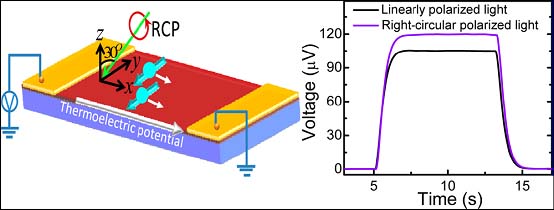Yuan Yan, Zhi-Min Liao, XiaoxingKe, Gustaaf Van Tendeloo, Qinsheng Wang, Dong
Sun,Wei Yao, Shuyun Zhou, Liang Zhang, Han-Chun Wu, and Da-Peng Yu
State Key Laboratory for Mesoscopic Physics, Department of Physics and
International Center for Quantum Materials, Peking University, Beijing 100871,
P. R. China.
Collaborative Innovation Center of Quantum Matter, Beijing, P. R. China
EMAT (Electron Microscopy for Materials Science), University of Antwerp,
Groenenborgerlaan 171, 2020 Antwerp, Belgium
Department of Physics, Tsinghua University, Beijing 100084, P. R. China
School of Physics, Beijing Institute of Technology, Beijing, 100081, P. R. China
King Saud University, Riyadh, 11451, Saudi Arabia
Thephotothermoelectric effect in topologicalinsulator Bi2Se3nanoribbons is
studied. The topologicalsurface states are excited to be spin-polarized by
circularlypolarized light. Because the direction of the electron spin islocked
to its momentum for the spin-helical surface states, thephotothermoelectric
effect is significantly enhanced as theoriented motions of the polarized spins
are accelerated by thetemperature gradient. The results are explained based on
the microscopic mechanisms of a photon induced spin transitionfrom the surface Dirac
cone to the bulk conduction band. Theas-reported enhanced photothermoelectric
effect is expected to have potential applications in a spin-polarized power
source.

|
Figure: Photovoltage generation from a single Bi2Se3nanoribbon device with
switching obliquely incident LP, RCP, and LCP light in the y-z
plane with a 30° angle between the direction of light and the z-axis (Nano
Letters DOI: 10.1021/nl501276e,2014).
|
